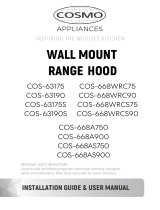
Alimentation électrique
IMPORTANT : Une prise électrique au plancher peut être soit encastrée soit
montée en surface, mais une prise électrique murale doit être encastrée pour
pouvoir effectuer le raccordement. Pour un câblage direct, le boîtier de
raccordement doit être monté sur le mur.
a
b
e
d
g
h
c
f
a 30" (76 cm)
b 111/2" (29.2 cm)
c 6" (15.2 cm)
d 71/4" (18.4 cm)
e 3" (7.6 cm)
f 17
1
/
2
" (44 cm)
g Emplacement conseillé pour
la prise électrique
h Emplacement conseillé
pour le raccordement à
l’alimentation en gaz
R
EMARQUE : Distance de séparation minimale de 24" (61 cm) lorsque le fond
d’un placard de bois ou de métal est protégé par une planche ignifugée d’au
moins 1/4" (0,64 cm) recouverte d’une tôle d’acier d’épaisseur égale ou
supérieure au calibre 28 MSG, d’acier inoxydable de 0,015" (0,4 mm),
d’aluminium de 0,024" (0,6 mm), ou de cuivre de 0,020" (0,5 mm). Distance de
séparation minimale de 30" (76,2 cm) entre le dessus de la table de cuisson et le
fond d’un placard de bois ou de métal non protégé.
Exigences d'installation
SPÉCIFICATIONS ÉLECTRIQUES
IMPORTANT : Utiliser un cordon d’alimentation à 3 fils, homologué UL, un
cordon d’alimentation de 30 ampères (queue de cochon); ou si les codes
locaux ne permettent pas la mise à la terre à travers le fil neutre, utiliser un
cordon d’alimentation à 4 fils, homologué UL, 30 ampères spécifié pour
une tension nominale de 250 volts et approuvé pour une utilisation avec
des cuisinières.
Si les codes locaux le permettent et un fil de terre séparé est utilisé, il est
recommandé qu’un électricien qualifié vérifie que le chemin de terre est
adéquat et que le calibre du fil de terre est conforme aux codes locaux.
Afin d’installer correctement votre cuisinière, vous devez déterminer le type
de connexion électrique que vous allez utiliser et suivre les instructions
indiquées ici.
•
La cuisinière doit être connectée à la tension électrique et fréquence
spécifiées sur le modèle / numéro de série de la plaque signalétique. Tous
les modèles sont conçus pour être raccordés soit à monophasée de
120/240V ou 120/208V CA, 60 Hz, 3 fils ou soit à une alimentation, 4 fils.
Tension et
fréquence
Ampères Circuit exigé
240V, 60 Hz 20A
25 Amp Circuit
208V, 60 Hz 17.4A
20 Amp Circuit
•
Lorsqu’une source d’électricité monophasée de 120/240 volts, 60 Hz/4
conducteurs (CA uniquement) est disponible, le circuit doit comporter
un dispositif de protection de 25 A maximum (ou 20 A si la source
d’électricité spécifiée sur la plaque signalétique est de 120/208 volts).
•
Pour les installations de fils directs, installer une boîte de dérivation
appropriée (non fournie). Un connecteur de conduit homologué UL de taille
appropriée doit être utilisé pour fixer correctement le conduit à la boîte de
dérivation.
I
MPORTANT Les codes locaux peuvent varier; les raccordements
électriques d’installation et de mise à la terre doivent être conformes à tous
les codes locaux applicables.
Si les codes locaux permettent la mise à la terre à travers le neutre de
l’alimentation électrique, connecter le fil neutre blanc et le fil de terre vert de la
cuisinière au fil neutre blanc de l’alimentation électrique.
Exigences d'installation
38 39




















 Cosmo Appliances COS-63190S-DL-PA Le manuel du propriétaire
Cosmo Appliances COS-63190S-DL-PA Le manuel du propriétaire
 Cosmo Appliances COS-63190S-DL-PA Le manuel du propriétaire
Cosmo Appliances COS-63190S-DL-PA Le manuel du propriétaire